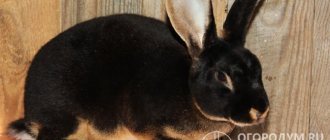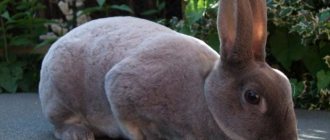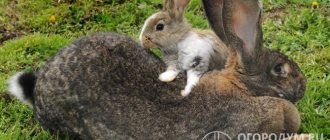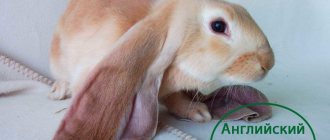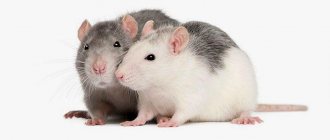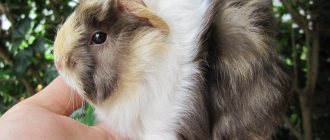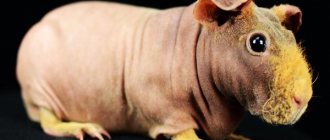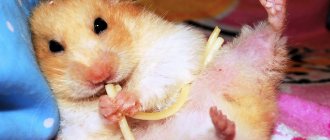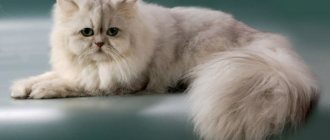The New Zealand rabbit is an unpretentious and easy-to-care breed that is very popular among farmers. It is believed that this particular species is the true standard of efficiency, since rabbits can be bred not only to obtain tender and juicy meat, but also valuable, perfectly smooth fur.
History of the origin of the breed
This type of rabbit comes from America; people first started talking about it in 1940. Many farms believe that the species originated in New Zealand, but this belief is erroneous. The breed was obtained by crossing the Belgian giants of Flanders and silver Champagne rabbits.
The first representatives of the breed turned out to be incredibly beautiful, with an interesting appearance. Scientists have set themselves the main goal - to obtain animals with snow-white fur. For the experiments, only albinos were used, and after a couple of generations, animals with red fur coats were completely absent from the litter. This species received the short name NZB, red ones - NZK.
In Europe, this species began to be in demand in 1921. It quickly gained popularity, but was registered in 1936.
Scientists did not stop working and continued to improve rabbits. In Holland in 1981, a new branch of the species was officially registered - an animal with black fur. This breed remains rare today, as it has received recognition in few countries. In external features the animal strongly resembles the Viennese black rabbit.
How the breed appeared
The New Zealand White rabbit was bred in 1910 in the USA. Today it is one of the most popular breeds in Europe and the USA. When breeding, breeders sought to obtain a white breed of rabbits without inclusions or other shades. At the same time, new individuals must have exceptional meat qualities. To obtain a new species, albinos of the New Zealand Red breed of rabbits and White Giants, also known as Flanders, were used.
The White Flanders is the closest ancestor of the New Zealand rabbit.
This breed was brought to Russia only in 1971. It has taken root well and is still bred on large and small farms. The New Zealand white rabbit endures harsh Russian winters and hot summer heat.
Today, these rabbits are bred for meat and fur, as a show breed. This species is also often used in laboratory research and breeding.
physical characteristics
New Zealanders are quite large in size - their body length is about 50 cm, their weight is almost 5-5.5 kg. The hind legs are large and strong, the back is fleshy. Due to these qualities, animals are used in meat production.
Most beginning farmers organize their business precisely on the basis of this type. Rabbit meat is a healthy and dietary product, so breeding these animals becomes a profitable business.
The body of the animal is covered with thick fur, there is sparse hair on the ears, they reach a length of almost 12 cm, and a short neck. It is believed that the smaller the rabbit's neck, the better it will be. The most popular are representatives of the breed with snow-white fur and red eyes.
Subtleties of content
The New Zealand rabbit has an excellent feature - it is one of the most unpretentious representatives of its species. But, nevertheless, like other eared breeds, certain conditions of detention should be adhered to:
The optimal temperature in a room with animals is +15+17 C, but the animals will grow wonderfully outside, but always in the shade.
- Constant air ventilation.
- Daily cleaning of cages.
- Control that there is no noise around the animals, that they are not exposed to bright light, and that they are not hot.
- Balanced diet.
Place of detention
The main role for New Zealand rabbits is where they are kept. The physical condition of animals depends on the quality of the cells.
The main rule when placing rabbit houses is to avoid drafts. They are the cause of many health problems for fluffies. However, you cannot completely close the cells, but on the contrary, they should be chosen as open as possible. Animals need a constant supply of clean air.
Cages for keeping New Zealand breed rabbits should be as spacious as possible, because this species does not tolerate cramped conditions. They are made of wood, or they can be completely mesh. It is worth noting that this breed’s paws have their own specific characteristics, so they do not suffer from the lack of a solid hard bottom. The houses can be placed separately or in tiers.
One dwelling can contain several same-sex individuals. It is better to house males separately. It is advisable to make rabbit cages of two types: winter (insulated) and for summer.
Feeding ration
Despite the fact that long-eared New Zealanders are not demanding in their diet, they are still a meat breed. Therefore, their diet should be carefully considered. Food should be fed with increased amounts of protein. Protein-rich nutrition accelerates muscle growth, growth and development of animals in general.
Diet of New Zealand breed rabbits
Varieties of New Zealand rabbits
The described type of rabbit is considered to be universal, because they make it possible to obtain both meat products and high-quality skin. Animals can also be raised for exhibitions, including medical research.
There are red and white representatives of the breed, but the latter type is in greatest demand. Each subspecies is characterized by certain advantages and valuable qualities.
New Zealand red rabbits
The rabbit of this subspecies has a smaller body size, which is why it differs from its white relatives. It is usually classified as a large species. It has a strong build, a small head, straight ears. Around the mouth and eyes, on the hips, belly and tail the coat is red, several shades lighter. The eyes are dark brown.
The coat is of medium length, shiny, not rough to the touch, soft and velvety, and has a uniform brick-red hue.
A strong maternal instinct manifests itself; a female brings 7-9 rabbits at a time. The offspring are characterized by early maturity. With proper and attentive care, by the age of 2 months the weight of baby rabbits can be about 2.5 kg.
In an adult, the body length is about 48-51 cm, body weight is in the range of 4-4.6 kg. Females always grow larger than males. The female rabbit has high fertility rates, but is less productive in comparison with white rabbits.
Can be kept in different climatic conditions. Ideal for beginning farmers, they make excellent pets as they quickly get used to people.
The average life expectancy of red rabbits is 10 years.
White New Zealand rabbits
White representatives of the breed have a pleasant to the touch, soft and delicate coat. The fur coat is an ideal white color, the head is not too large, short ears about 10 cm long are placed symmetrically. A short neck, compact body, well-developed muscles.
Short muzzle, slightly hooked nose, wide profile. Females are distinguished by a more delicate appearance and smaller size compared to males. The eyes are small and red, which confirms their origin - albinos.
The paws are straight, strong and thick, and can be flesh-colored or white. The back smoothly turns into a large and wide sacrum, the croup is rounded. The live weight of the white New Zealand rabbit reaches 4.5 kg.
Features of reproduction
The size of females of this breed exceeds the size of males. Female rabbits are distinguished by high fertility and excellent maternal qualities. In one litter they can give birth to up to 10 cubs. Newborn animals weigh up to 50 grams.
Since a nursing mother has high milk production, babies begin to quickly gain weight and develop well. Almost all young animals can be preserved due to high levels of maternal qualities. Female rabbits do not refuse feeding, do not eat babies, and do not scatter them.
In order to breed pets of this breed in order to obtain meat and skins, it is necessary to correctly select individuals for reproduction. To get offspring, it is necessary to mate males and females at the age of 4 months. It is unacceptable to mate animals from the same bloodline.
Females become sexually mature at the age of 4 months, and males at the age of six months. On average, one female can give birth to up to 40 viable young throughout the year. After the animals are born, they need to be vaccinated at the age of 28 days.
What does it take to start breeding a breed?
To start breeding New Zealand rabbits, large financial expenditures are not required. It is enough to choose the right rabbit, provide a place for the animal to live comfortably and stock up on the necessary amount of food. All investments pay off literally after the birth of the first rabbits.
Feed
Most of the animals' diet should consist of fresh grass, which is why feeding in the summer will not be a major expense. It is most profitable to breed rabbits outside the city, since within the city every day it turns out to be problematic to find the required amount of greenery. Especially if the farmer has a large number of individuals.
When collecting grass, the environmental component is important - urban grass cannot be considered an environmentally friendly product. Such nutrition can cause great harm to the rabbit's health.
To feed 20 rabbits you need about 1 bag of fresh grass every day. Greens are added to the cage as the rabbits eat it, but do not give too much grass. Such actions will lead to severe contamination of the cell. In addition, animals simply will not eat dirty or not fresh grass, which can cause them to remain hungry.
Read the article about how and what to feed rabbits.
Do not forget about the grain component of the diet. Compound feed is suitable for this, which can be purchased at the poultry market. The cost of one bag is about 500 rubles. Depending on the overall diet, it is determined how much food will be enough. It is best to use additional complementary foods, and then 1 bag of compound feed will be enough to feed 20 rabbits for about 14 days.
Place of detention
A specialized store sells ready-made enclosures or cages, but you can also make them yourself, if possible. It is better to opt for professional cages, which come in a variety of designs. There are also multi-level cells with varying degrees of complexity.
Subject to the purchase of a finished product, in order to equip a future rabbit farm, you need to immediately make a large investment. The average cost of one finished cell is approximately 10,000 rubles. There can be no more than 4 adults in one cage.
If it is not possible to make large financial investments, you can start making cells yourself. Such designs will be simple, but durable and easy to implement. You can use plywood, natural wood, metal mesh and simple boards.
The ideal option would be to make the simplest and most functional cells. Be sure to consider the following points:
- use only a strong mesh so that animals cannot gnaw it;
- there must be room inside the cage for free movement of animals;
- consider good ventilation, as stale and stagnant air leads to the rapid development and spread of bacteria, which ultimately leads to a global epidemic;
- if you equip a mesh floor and the cage is in a suspended position, this will greatly facilitate the cleaning process and will not allow waste to accumulate;
- feeders and drinkers should always be freely accessible.
In enclosures where females and offspring are kept, there should also be individual houses. In such houses, the female rabbits themselves arrange the nest necessary for the comfortable living of the young.
When designing a cage, take into account certain characteristics of these animals:
- the male must have a separate cage, since rabbits can fight among themselves, so you should not constantly keep him together with the female;
- several individuals can be placed in one cage, but these must be young rabbits of the same age;
- Before giving birth, the female rabbit moves to a separate housing, since the young offspring may be trampled or killed by other animals.
Number of rabbits
At the initial stage, one of the most important points is the number of animals. To find out how profitable and promising the project will be, you will need to be patient. You should not immediately buy a herd, since only 2-3 females and one male will be enough. Such a number of animals will help you understand whether it is worth pursuing the business further, and will also allow you to acquire the necessary skills in caring for rabbits.
A small farm does not require any large financial investments or time expenditure. However, subject to a competent approach, full return will occur in the very near future. The reproduction rate of rabbits is high, so within a month you can get a full-fledged herd, which will bring a good income.
Selecting a suitable individual
Choose a young and healthy female with a male for breeding. To be confident in the breed, give preference to trusted breeders.
Feeding
Competent and moderate nutrition is important for this breed, since they are prone to obesity, and when using low-quality food, the quality of the fur decreases. Feeding is carried out twice a day.
The daily diet should include:
- quality hay;
- concentrated feed;
- root vegetables (carrots or beets);
- aspen branches;
- grains of oats, wheat or corn.
The recommended feeding rate for adults is 160-200 g per day; for pregnant and lactating females, as well as before preparing for mating, the rate is raised to 330-400 g.
Rabbits should absolutely not be fed lettuce, mushrooms, cabbage, or tomato leaves. It is not recommended to offer nuts, sugar, bread and turnips. Greens should be given to New Zealanders with caution to avoid digestive problems.
The cage should have free access to clean and fresh water, which should not be boiled, as this will wash away all minerals and oxygen. To provide drinking water, it is recommended to use nipple drinkers, and if there are a large number of animals in the herd, bunker feeders are considered optimal for feeding.
Features of maintenance and care
New Zealanders do not require much grooming. It is enough to provide spacious and clean cages, and take care of good nutrition. Rabbits have hard, thick hair on their feet, so they feel comfortable on a mesh floor.
In the summer, they can live in portable cages that do not have a bottom. Specially equipped professional cages can also be used, ideal for winter living. Same-sex individuals should be placed in a separate section of the cage.
Conditions
To raise healthy New Zealanders capable of mating, adhere to several conditions:
- In the room where cages with animals will be located, maintain the temperature within 20 degrees.
- Provide good ventilation, but avoid drafts, as this can negatively affect the health of the animals.
- Choose cages that are spacious enough. You can also choose fully mesh options. Even the lack of a flat floor surface does not cause any inconvenience to the animals.
- Arrange cages in 2-3 tiers, do not forget to add feeders and drinkers to each house. How to make a drinking bowl yourself is written in this article.
- Keep individuals of approximately the same age and gender in the same house. You can select animals by size.
- Large and adult individuals require large cages so that they feel comfortable and can move freely.
- Clean the cage regularly, otherwise the fur will begin to deteriorate due to constant dirt, especially in white rabbits. Animals that live in clean cages have a significantly higher taste of meat.
New Zealanders do not like loud noise, bright lighting and heat. To successfully breed representatives of this breed, eliminate these factors. If individuals live in favorable conditions, rabbits quickly gain body weight and produce regular offspring.
Nutrition
New Zealanders are not picky when it comes to nutrition, but for proper growth they need to have a balanced diet. If the rabbit eats properly and nutritiously, the meat will be tender and juicy, with a moderate percentage of fat, and there will be no specific smell of rabbit meat.
Summer and winter diets have certain differences. But there is a main rule - a varied menu. You can only give fresh food with a sufficient content of nutrients and vitamins.
The summer diet should include different types of herbs and fresh herbs, plantain with dandelions and clover.
The winter diet consists of:
- high quality grain feed;
- hay;
- coniferous branches;
- a variety of root vegetables.
Vegetables and fruits should be introduced into the diet with great caution. Let's do no more than the rabbits can eat at one time. If animals begin to eat spoiled foods (for example, fruits begin to rot in the summer and freeze in the winter), serious digestive problems may arise. The rabbits begin to feel unwell and get sick.
Most often, representatives of this breed are bred for meat. That is why it is so important to correctly create a varied and balanced menu. It is strictly forbidden to overfeed rabbits, as the presence of excess fat and large body weight can cause death.
Rabbits experience such a natural need as grinding their teeth, so be sure to place a thick piece of wood (round) or a salt stone in the cage.
Additional care
Additional care does not cause any particular difficulties, but it allows you to maintain good health of rabbits, making their breeding more profitable. To do this you need:
- Regularly undergo a veterinary examination - at least once every 6 months.
- Preventive vaccinations can prolong the life of rabbits and prevent the risk of contracting a dangerous disease.
- Regularly remove tangles and comb the wool, maintain the ideal condition of the skin, especially if you plan to sell it in the future as a secondary product. Pay the most attention to the belly area to prevent matted fur. Use a special comb for this.
- After the washing procedure, the rabbit must dry well, but only in a warm room, otherwise there is a risk of catching a cold.
- When swimming, be careful not to get water into your ears. This can lead to the development of otitis, which is very difficult and long to treat.
- Do not bathe animals too often, as constant wetness negatively affects the beauty of the fur. For washing, use only special shampoo, which can be purchased at a veterinary clinic.
Price
New Zealand white rabbits can be purchased starting from 500 rubles for one month-old individual. NZKs are a little more expensive; prices from good breeders start from 1000 rubles.
The black variety of New Zealanders is quite rare on sale; they are usually sold as ornamental animals. The cost starts from 3000 rubles.
You need to purchase rabbits only from trusted breeders or farmers who have all the necessary veterinary and sanitary quality certificates.
For commercial cultivation and subsequent breeding, you need to buy only healthy and strong individuals that do not show signs of disease. Particular attention should be paid to the condition of the ears, eyes and check the genitals. A young rabbit should be active and curious.
Rabbit breeding
Rabbit breeding is a promising line for starting a small business. Rabbit meat is considered one of the most healthy high-quality products, which is always in great demand among consumers.
If the main goal of starting breeding is to obtain meat and resell it, think in advance about where you will sell it. Prepare several sales channels for your products, be sure to consider the scale of your own farm and how much meat you can offer.
In the first stages of breeding, to make sure whether you can do this business or not, it is better to raise rabbits for your own needs. If everything goes well, and caring for the animals does not cause any problems, the business promises to begin generating good profits in the near future.
Preservation of the White Giant breed
Since rabbits can very quickly lose their breed qualities, if there is incorrect breeding classification, errors in feeding and maintenance, you need to constantly be on the alert and ensure that the breed is kept clean. They monitor the most obvious deviations from standards, which are easy to detect even for a non-professional. They look at two main parameters:
- skin defects (fur is a genetically fixed characteristic of the breed),
- slaughter weight (a decrease in the weight of a rabbit after slaughter is evidence of the degeneration of the breed).
Specific examples of deviations from the White Giant breed standard:
- uneven hairline;
- the appearance of fluffy fur (non-standard fur color);
- reduction in early maturity and slaughter yield in 90-120 days by more than 56-59%.
What do rabbits get sick with?
Like any other animal, rabbits can suffer from various diseases. The most common problems are:
- Myxomatosis - manifests itself as tumor-like formations on the paws and head; they can also appear on the genitals, often merging into large swelling. Infection occurs from parasites, infected rabbits and other rodents. Be sure to completely disinfect the cage and send all suspicious individuals for slaughter.
- Viral hemorrhagic disease - most often affects animals over 1 year of age. Externally, the disease manifests itself as a lack of appetite and mood, tilting of the head and convulsions. Disinfect the cages and destroy sick rabbits. As a preventive measure, get vaccinated.
- Coccidiosis affects young animals between 2 and 4 months of age. Manifested by general weakness, diarrhea, yellowness of the mucous membranes. Be sure to remove all infected individuals and contact your veterinarian about the problem. Prevention is frequent cleaning of cages with feeders, preparation of a balanced diet (the amount of legumes with bran is minimized).
- Rhinitis - manifested by sneezing, runny nose, high fever. Isolate all sick rabbits and instill furatsilin solution into the nose.
- Infectious stomatitis - affects young animals aged 1 to 3 months. It manifests itself as a wet face, ulcers appear on the mucous membranes, which provoke increased salivation. For treatment, pour streptocide powder into the oral cavity; to treat ulcers, use a solution of copper sulfate.
Carry out regular inspection of all animals and if suspicious signs or unusual behavior appear, isolate the rabbit and then show it to the veterinarian. Only after determining the diagnosis can you understand how serious the situation is and what measures need to be taken to minimize the likelihood of negative consequences.
Features of vaccination
The first vaccine is given to babies at the age of 28 days. It is intended for the prevention of myxomatosis. The next vaccine is given at the age of one and a half months, it will protect against viral hemorrhagic disease. Repeated vaccination is carried out after 3 months, then once every six months.
It is necessary to purchase vaccination preparations only from veterinary pharmacies. Be sure to read the instructions before vaccinating. If necessary, contact a veterinarian.
Tips for beginning breeders
First you need to decide why the animals are raised - for meat, wool or for sale. Each option has certain subtleties that are related to maintenance, care and nutrition. Of course, the differences are not too strong, so the breeder must set a clear and specific goal.
When purchasing, it is very important to choose completely healthy animals that will easily get used to their new place of residence. Consequently, they will grow quickly and produce offspring.
When choosing rabbits, pay attention to the following factors:
- Age – 3 months old are considered ideal. Younger individuals may die as a result of weaning from their mother or a sudden stop in milk feeding.
- External characteristics - rabbits should be sufficiently well-fed, the fur coat is dense and shiny, the ears are clean, the eyes are light, without swelling, and the face is dry.
- Behavior – a healthy animal is active and moves around the cage with pleasure.
Be sure to check with the seller how the rabbits ate, since the diet cannot be changed when transported to a new place. Find out what vaccinations were carried out, if any.
Maintenance of pregnant females
For pregnant females, it is recommended to build a separate cage structure. It should have a nest that helps hide the offspring from prying eyes.
Some rabbit breeders prefer to build a small house to further house the rabbit. If it is not possible to make such a structure, then the way out of the situation would be to use a large amount of soft hay. It is not recommended to place thorny types of dry plants in a cage. They can injure the delicate skin of rabbits. To make the nest seem cozy and soft, the female uses her own down, with which she covers the entire space.
Pregnant rabbits should be placed in a different room to reduce stressful situations
Particular attention must be paid to their diet. Food for individuals should be high in calories
The rabbit's menu may include grain and cereal mixtures, large volumes of juicy greens, and, in winter, hay.
New Zealand rabbits as pets
Often rabbits of the described breed are kept as pets. These animals are friendly and very smart, which is how they differ from dwarf animals. The latter absolutely do not like to be in the arms of a person for long periods of time.
New Zealanders quickly become attached to the owner who gives them food, and enjoy playing with children. Maintenance is not particularly difficult and no special diet is required. Rabbits can get sick, so they need to be brought to the veterinarian for regular checkups.
The average lifespan of an animal is 5 years. If the male is castrated and lives in favorable conditions, this figure increases to 10 years.
An overview of the New Zealand Rabbit is presented in the following video below:
Diseases and prevention
If quality care is maintained, New Zealanders practically do not get sick.
You should carefully monitor the animals' discharge and their general condition; if there is unusual lethargy, you should immediately call a veterinarian. To treat New Zealand rabbits, the drugs Baytril, Loseval, and Selenium-E are used.
A prerequisite is timely vaccination against myxomatosis, rabies and VGBV. In the future, it is necessary to strictly adhere to the revaccination schedule.
Combination vaccinations are now very popular. They allow you to immediately protect your pet from several infectious diseases.
Business plan with approximate calculations
Before purchasing rabbits, it is worth asking about the prospects of the business and how profitable it will be from a financial point of view. It is necessary to understand exactly what results properly organized and productive work will lead to. To begin with, you can consider purchasing three female rabbits and one male of this breed.
To ensure comfortable living conditions for animals, you need to prepare cages in advance, of which there must be at least 10 - purchased rabbits will be in 4, and the rest will remain empty until offspring appear. It is advisable that the enclosure be about 150x60x60 cm in size. You can make it yourself - take a mesh (4.5 sq. m) and wooden slats (6 m). Place the enclosure at a height of at least 1 m from the ground.
The cost of the mesh is 200x4.5=900 rubles, the slats are 50x6=300 rubles. The approximate cost of the enclosure will be about 1200 rubles. Don’t forget about spending on rabbits - the average cost of one individual is approximately 800 rubles. To purchase 4 animals you will need 3200 rubles.
In the first week, purchased animals require special care until they get used to the new place. Then you can start knitting directly. The female bears the offspring for a month; mating takes one week. After approximately 2 months, after the purchase of the first animals, offspring will appear.
In one year of raising rabbits you can get approximately the following result:
- from the primary herd – 4 adults;
- from the first drive - 15 individuals, completely ready for sale;
- from the second drive - 15 female rabbits ready for mating;
- approximately 50 rabbits.
Then the breeder can independently maintain the number of animals at the desired level. For breeding, be sure to leave 2 healthy and best males. Consequently, approximately 30 adults will be ready for sale each month. We should not forget that under unfavorable conditions or poor nutrition, a high mortality rate can be observed.
For food, over 12 months, you will have to spend about 1000 rubles to purchase hay and about 3000 rubles to buy 5-6 bags of feed. Initial costs will require an investment of approximately 10,000 rubles.
Rabbit meat at wholesale price - 300-350 rubles per 1 kg. An adult rabbit weighs on average about 4.5 kg. Therefore, if you sell 30 adult individuals every month, you can get approximately 40,000 rubles. Skins are also suitable for sale - one piece costs about 200 rubles (the cost of unprocessed raw materials).
Breeding rabbits is not only profitable, but also a business that pays off quickly. If you put your business on stream correctly, there is an opportunity to earn a good amount and provide a regular income. Depending on the size of the herd, the profit received will also increase.
Video
We invite you to watch several videos detailing the various features of New Zealand rabbits and comparing their productivity with their outbred “relatives”:
Loving husband and caring father. A versatile person, interested in literally everything. Gardening themes are no exception. I'm always happy to discover something new and share it with other people. He is of the opinion that nature is a second home for every person, therefore it should be treated with respect.
Found a mistake? Select the text with the mouse and click:
Humus is rotted manure or bird droppings. It is prepared like this: the manure is piled up in a heap or pile, layered with sawdust, peat and garden soil. The pile is covered with film to stabilize temperature and humidity (this is necessary to increase the activity of microorganisms). The fertilizer “ripens” within 2-5 years, depending on external conditions and the composition of the feedstock. The output is a loose, homogeneous mass with a pleasant smell of fresh earth.
“Frost-resistant” varieties of garden strawberries (more often simply “strawberries”) need shelter just as much as ordinary varieties (especially in those regions where there are snowless winters or frosts alternating with thaws). All strawberries have superficial roots. This means that without shelter they freeze to death. Sellers’ assurances that strawberries are “frost-resistant,” “winter-hardy,” “tolerates frosts down to −35 ℃,” etc. are deception. Gardeners must remember that no one has yet managed to change the root system of strawberries.
Both humus and compost are rightfully the basis of organic farming. Their presence in the soil significantly increases the yield and improves the taste of vegetables and fruits. They are very similar in properties and appearance, but they should not be confused. Humus is rotted manure or bird droppings. Compost is rotted organic remains of various origins (spoiled food from the kitchen, tops, weeds, thin twigs). Humus is considered a higher quality fertilizer; compost is more accessible.
Oklahoma farmer Carl Burns developed an unusual variety of multi-colored corn called Rainbow Corn. The grains on each cob are of different colors and shades: brown, pink, purple, blue, green, etc. This result was achieved through many years of selecting the most colored ordinary varieties and crossing them.
Natural toxins are found in many plants; Those grown in gardens and vegetable gardens are no exception. Thus, the seeds of apples, apricots, and peaches contain hydrocyanic acid, and the tops and peels of unripe nightshades (potatoes, eggplants, tomatoes) contain solanine. But do not be afraid: their number is too small.
You need to collect medicinal flowers and inflorescences at the very beginning of the flowering period, when the content of nutrients in them is highest. Flowers are supposed to be picked by hand, tearing off the rough stalks. Dry the collected flowers and herbs, scattered in a thin layer, in a cool room at natural temperature without access to direct sunlight.
One of the most convenient methods for preparing a harvest of vegetables, fruits and berries is freezing. Some believe that freezing causes the nutritional and health benefits of plant foods to be lost. As a result of the research, scientists have found that there is practically no decrease in nutritional value when frozen.
A new product from American developers is the Tertill robot, which weeds weeds in the garden. The device was invented under the leadership of John Downes (creator of the robot vacuum cleaner) and works autonomously in all weather conditions, moving over uneven surfaces on wheels. At the same time, it cuts off all plants below 3 cm with the built-in trimmer.
It is believed that some vegetables and fruits (cucumbers, stem celery, all varieties of cabbage, peppers, apples) have “negative calorie content,” that is, more calories are consumed during digestion than they contain. In fact, only 10-20% of the calories received from food are consumed in the digestive process.
https://fermhelp.ru/opisanie-porody-novozelandskij-krolik/https://krolist.ru/info/porody/novozelandskij-k.htmlhttps://ogorodum.ru/novozelandskij-krolik.html
Sales of the finished product
The issue of product sales is of primary importance. It needs to be thought through even before the first batch of the finished meat product arrives. By this time there should already be a buyer. For all suppliers, selling their own product always comes first.
Don't forget that you also need to take care of advertising. In order for people to want to purchase a product, they must know what offer is available. The main emphasis should be on high quality meat, because this will allow you to get regular customers.
Do not neglect self-promotion, because every buyer wants to purchase quality meat directly from the farmer, without dealing with intermediaries.
Reviews about the breed
★★★★★
Lyudmila, 40 years old, amateur farmer, Omsk. I recently decided to get rabbits, chose the New Zealand breed and did not regret it.
The meat is incredibly tasty, and the skins are excellent, although they are considered a secondary product. Another feature was high fertility. ★★★★★
Arseny, 35 years old, economist, Voronezh. I really liked the appearance of the rabbits of this breed.
What was important to me was the unpretentiousness of the animals and ease of care, which is what I was able to achieve. Due to the high taste of the meat, I decided to breed this breed. Hide
Add your review
New Zealand rabbits are a very attractive breed. They have an interesting appearance; beautiful animals can literally captivate at one glance. They are attracted by the excellent physical characteristics, smooth coat and size of animals that are distinguished by their ease of care, excellent fertility and endurance. Representatives of this breed are a good start for business.
0
0
Copy link
White New Zealand Eared Ears
In areas where rabbit breeding is active, white New Zealanders are extremely successful. This variety of the breed was obtained through the selection of albinos, later bred with Belgian giants. As a result, individuals were obtained whose characteristics include such definitions as a strong skeletal system, developed muscular apparatus and a snow-white skin.
New Zealanders with a white coat are significantly larger than their red relatives. They are bred to produce dietary meat with excellent taste, as well as white skin. NZB fur is in great demand among fashion designers. This can be explained by the fact that any paint is evenly distributed on it. For example, in Hungary, white rabbits of the New Zealand breed produce up to 30 rabbits as offspring. And the females of this breed have enough milk to keep the rabbits well-fed.

